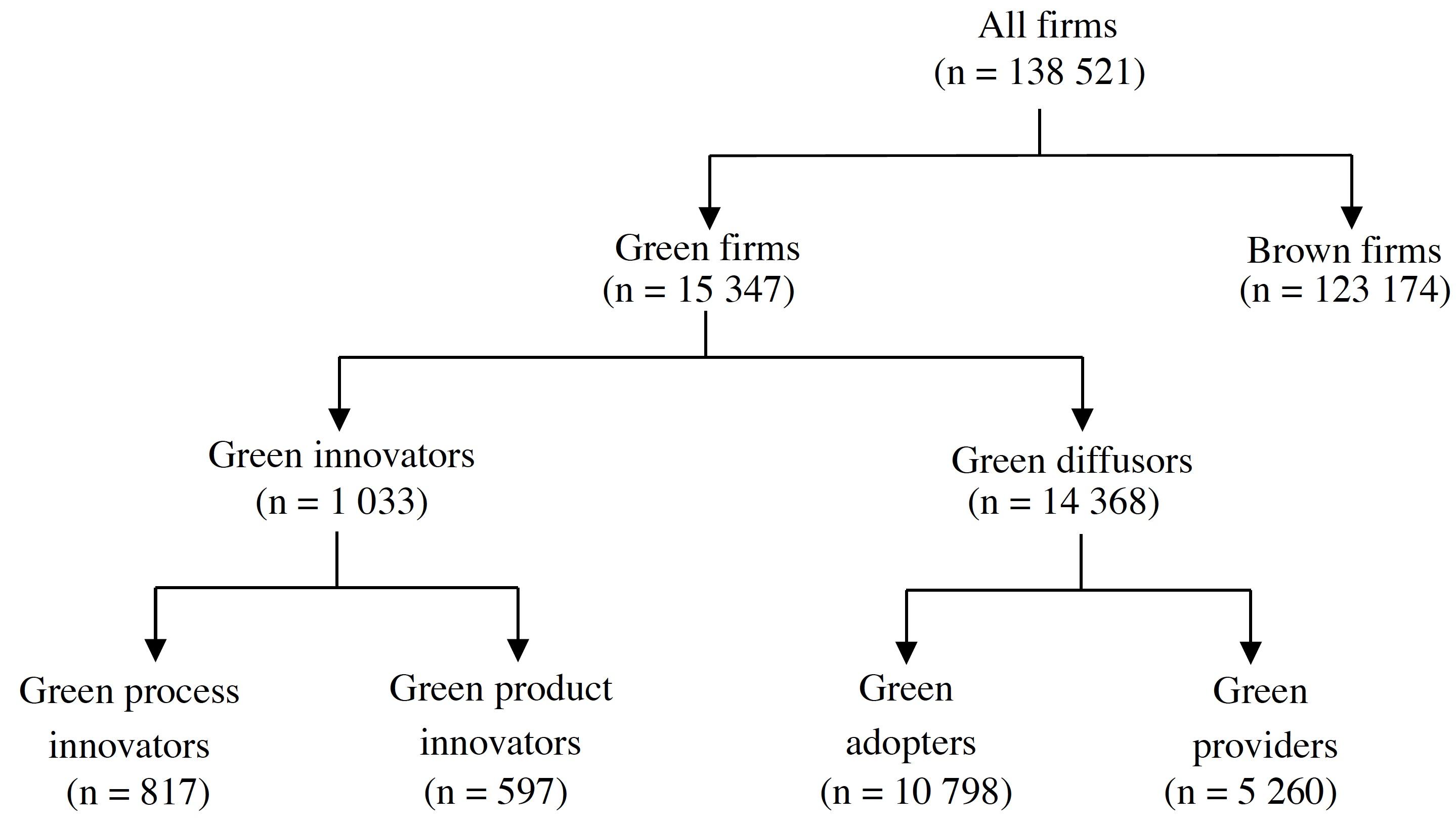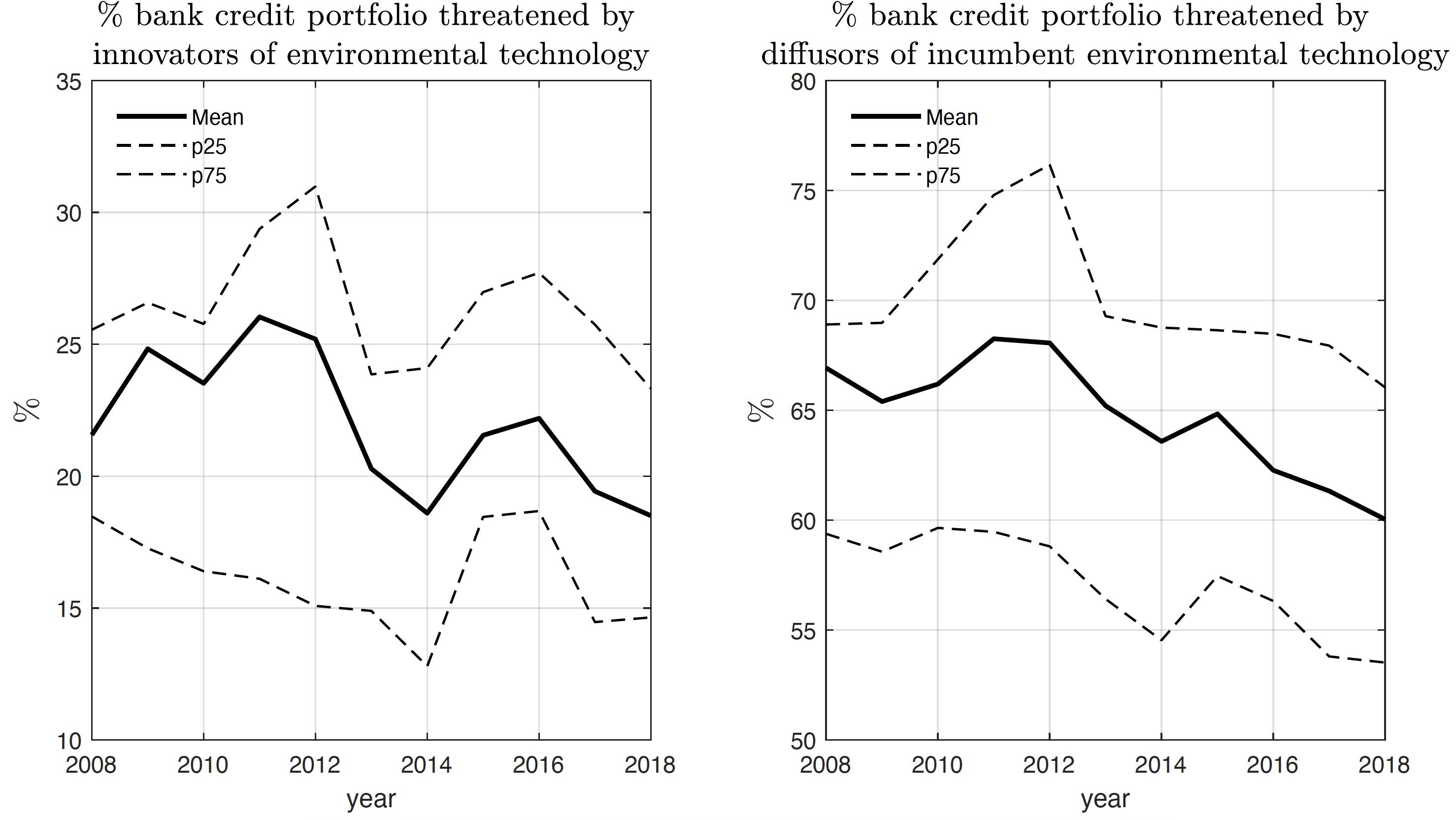Addressing climate change is one of the most pressing priorities of our time. There is a broad consensus that both low-carbon innovations and their widespread uptake are essential to mitigate the magnitude and impact of climate change. To support these activities, Borio et al. (2022) identify the important role of finance but also point at the need for adequate policymaking in the real economy (see also De Haas and Popov 2022 and Giglio et al. 2021 on climate finance).
In a recent paper (Degryse et al. 2022), we study – theoretically and empirically – the effect of an investor’s legacy portfolio on his decision to fund new technologies when they adversely affect the value of the investor’s original portfolio. Our model’s main testable prediction formalises that the market structure of the financial system’s asset overhang plays a crucial role in determining the extent of aggregate funding supply to new disruptive technologies. In particular, in financial systems in which all financiers have a large legacy portfolio exposed to a new technology, all financiers have incentives not to support this technology’s development or widespread uptake. Why? The strategy of deliberately not investing in a (standalone profitable) technology prevents the adverse spillovers on their legacy investments. However, the presence of investors with limited or no exposures to the negative impact triggers credit supply by the entire system (including from financiers heavily impacted by the new technology) as negative externalities cannot be prevented in that case.
Empirical application
Although asset overhang can hinder the development and widespread uptake of any new technology, the paper zooms in on its role for low-carbon technologies. More precisely, our empirical application studies, in the setting of a heavily bank-based economy (Belgium), whether green technologies suffer from an asset overhang problem in the market for corporate bank credit. The climate–banking nexus constitutes a tight conceptual match with our overhang framework as it uniquely combines large threats of disruptive environmental technologies and strong exposures across the population of banks towards transition risk.
Our application first pins down the externalities to which firms are exposed when other firms unfold their environmental activities. The linchpin of our identification strategy has two main features. First, in the spirit of Hall and Helmers (2013), we take a two-tiered view of environmental activities. Green activities either take the form of green innovations (i.e. development of new environmentally friendly products and production processes) or green diffusion (i.e. adoption or selling of environmental products and services that embody an incumbent green technology). Drawing on various unique large-scale datasets, we directly observe both components of technological change at the firm level (Figure 1). This bifurcated view is warranted as the two activities differ in their financing and disruptive capacity (Utterback 1974) – and therefore might trigger different levels of overhang problems – while both are instrumental to the net zero transition (Aghion et al. 2009). Second, following Bloom et al. (2013), we empirically distinguish each firm’s position in the technology space and product market using granular information on the distribution of firms’ input and output markets (inferred from detailed B2B transactions). This allows us to construct distinct measures of economic distance between ‘firms with environmental activities’ and ‘other firms’ in the technology (input) and product (output) market dimensions. We leverage both ingredients to trace out adverse spillovers of green activities on neighbouring dirty firms.
Figure 1 Incidence of various green activities by Belgian firms
We focus on two types of externalities that were previously documented to weigh heavily on banks’ lending decisions: firm performance (as proxied by firm household sales, corporate sales, market shares, etc.) and pledgeable asset values (measured by, inter alia, losses incurred on secondary markets upon liquidation of tangible assets). The former is taken from granular VAT declarations. The latter are taken from a widespread business survey. We apply this framework to a panel of Belgian firms over the period 2008–2018 and document that firms with green innovation and/or green diffusion generate negative spillovers on brown firms through deteriorated firm performance and asset devaluations.
We provide further corroborating evidence that these induced firm-level externalities stemming from green technology effectively feed into banks’ assessments of their incumbent borrowers. First, we find that green innovation and diffusion are associated with elevated probabilities of default and additional provisioning reported by banks on their incumbent dirty borrowers. Second, we observe adjustments in market values of firms’ capital in the face of (particular types of) environmental innovation and adoption by technology peers.
Armed with the established externalities, the second step in our analysis is to quantify the share of individual bank’s legacy positions threatened by each individual firm’s green activities using bank-firm credit exposures as reported in the corporate credit registry. This allows us to study the impact of the magnitude and structure of the banks’ legacy portfolio at risk on credit allocation to environmental firms. A priori, banks are expected to take on board these exposures in their lending decisions as Figure 2 reveals a significant amount of the corporate credit portfolio at risk to the population of innovators and diffusors of environmental technology.
Figure 2 Share of banks’ corporate credit portfolio negatively exposed to environmental innovators/diffusors
Empirical findings
We estimate that:
- At the extensive margin, an environmental innovator (diffusor) which generates a one standard deviation negative impact on each bank in the credit market is around 4.4 percentage points (1.0 percentage points) less likely to receive bank credit compared to an environmental innovator (diffusor) that does not have an impact on banks’ legacy positions.
- The rationing effect is largely muted by the presence of intermediaries with low asset overhang.
- We further study, conditional on lending, which bank in the asset overhang spectrum matches up with the green firm. We find that the bank with the smallest asset overhang is 8.4 percentage points more likely to grant a loan to the green firm relative to any other bank in the system. That is, investors with less asset overhang are more likely to ‘break the barrier’ to technological disruptions.
- At the intensive margin, we document that changes in the asset overhang of the incumbent lender do not play a role in credit supply to the environmental firm. Instead, a 1 standard deviation decrease in the lowest asset overhang position (potentially, but not necessarily, that of the incumbent lender) drives up credit supply by the incumbent lender to the disruptive innovator (diffusor) by 0.11 standard deviations (0.05 standard deviations).
Taken together, these results highlight that the distribution of asset overhang across investors determine credit supply to disruptive firms both at the extensive and – once the rationing barrier is broken – at the intensive margin.
Policy implications
The results from our paper talk to a number of ongoing policy debates.
- First is the promoting of financial intermediaries with no legacy exposures that would suffer from technological disruption. Since these legacy-free investors do not face an overhang problem, they are able to stimulate entry of profitable firms despite the possibility of negative spillovers on other intermediaries’ legacy positions. In the context of climate change and to the extent that these intermediaries have sufficient industry expertise, public ‘green banks’ initiatives such as the UK Green Investment Bank or the New York Green Bank could therefore be key to reducing barriers to entry for more low-carbon firms. In addition, our results indicate that the entry of such a single legacy-free green bank in the economy breaks the system-wide rationing barrier to disruptive green firms. As a result, the total capacity of credit supply to the green economy gets compounded beyond the individual capacities of the novel green bank, ultimately including all banks in the system.
- Second, our results suggest that macroprudential policies concerned with technological disruption could introduce costs related to legacy exposures. In the climate change context, such a penalty could take the form of risk-weight reductions (additions) in the prudential framework for banks’ exposures to green (brown) assets. Another example would be the promoting of collateral policies that penalise the use of assets exposed to the type of green externalities documented in our paper.
Our theory posits that an asset overhang materialises when new technologies have a large potential for adverse spillovers to which the full pool of eligible investors is exposed. While the climate–banking application satisfies these criteria, there are other applications which meet similar conditions, thereby warranting an overhang analysis as well. For instance, the pool of candidate investors in advanced niche technologies (AI, cloud computing, biotech etc.) is typically restricted due to the intimate knowledge required to screen candidate projects. This screening ability is typically acquired through experience in funding projects embodying similar or adjacent technologies which may potentially suffer from the entry of disruptive rivalling projects. If the latter legacy projects still feature on the investors’ balance sheet, they have an incentive to ringfence their legacy from competing novel technologies.
References
Aghion, P, R Veugelers, and C Serre (2009), “Cold start for the green innovation machine”, Bruegel Policy Brief 12.
Bloom, N, M Schankerman, and J Van Reenen (2013), “Identifying technology spillovers and product market rivalry”, Econometrica 81: 1347–1393.
Borio, C, S Claessens and N Tarashev (2022), “Finance and climate change risk: managing expectations”, VoxEU.org, 7 June.
de Haas, R and A Popov (2022), “Finance and green growth”, The Economic Journal, forthcoming.
Degryse, H, T Roukny and J Tielens (2022), “Asset overhang and technological change”, CEPR Discussion Paper 17507.
Giglio, S, B Kelly, and J Stroebel (2021), “Climate Finance,” Annual Review of Financial Economics 13: 15–36.
Hall, B H and C Helmers (2013), “Innovation and diffusion of clean/green technology: Can patent commons help?”, Journal of Environmental Economics and Management 66: 33–51.
Utterback, J M (1974), “Innovation in industry and the diffusion of technology”, Science 183: 620–626.








